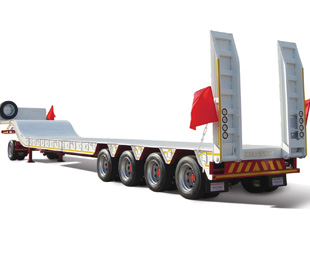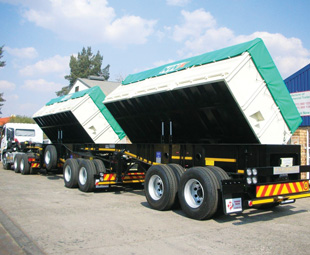Trailered for success

Trailers are pivotal to the transportation of goods globally, and while they may sit aft, they’re definitely no afterthought – the road freight industry would be lost without them. JACO DE KLERK takes a look at what’s trending in this area in and beyond South Africa.
One of the latest leaps forward within the local trailer industry is the innovative tracking system recently launched by MiX Telematics. According to Gert Pretorius, managing director of the company’s Africa Fleet Solutions arm, trailer tracking has the potential to become one of the fastest growing sectors in the local telematics market.
He says South African fleet managers are anxious for solutions that will enable them to both manage and track their trailers as well as their associated high-value or high-risk loads. “We saw a huge opportunity to bring into the market a trailer tracking solution that is self powered and not only allows you to see the unit on a map, but gives you additional functionalities as well,” explains Pretorius.
This new trailer tracking solution, with its two derivatives, enables fleet managers to have complete control over both the locations and activities of their trailers, whether stationary or on the move. This is made possible through the utilisation of GPS and GPRS (general packet radio service), which enable trailer tracking activity to take place independently of the truck-tractors and their onboard computers. The tracking units also cater for trailers with or without a permanent power source, and are available in a wired and wireless option.
 The wired version connects directly to the power source of the horse, but it can still send some information in off-hook status thanks to a battery pack. The wireless unit, on the other hand, doesn’t require additional energy because it can draw all the power it needs from its longer-lasting battery, which can operate effectively for up to 12 months between exchanges.
The wired version connects directly to the power source of the horse, but it can still send some information in off-hook status thanks to a battery pack. The wireless unit, on the other hand, doesn’t require additional energy because it can draw all the power it needs from its longer-lasting battery, which can operate effectively for up to 12 months between exchanges.
“A further benefit of the battery unit is that it can send a ‘low battery’ notification to the user when it gets close to the end of its life,” Pretorius points out. “This means the customer won’t end up sitting with a unit that doesn’t function properly.”
He adds that knowing the location of one’s trailers at all times means that fleet utilisation, and thus fleet efficiency, can improve dramatically. Instances of lost trailers can also be reduced, regardless of whether they are coupled to or detached from their truck-tractor.
“Until now, fleet managers have had to rely on information derived from their trucks to manage their trailers,” emphasises Pretorius. “This has made the separation between a truck and its trailer both unsafe and inconvenient – especially when high-risk or high-value loads are involved.”
Being able to manage trailers independently of trucks is highly beneficial to organisations that usually rely on outsourced or sub-contracted truck operators for information about their trailers and loads.
“It’s crucial to know where your high-value and high-risk assets and loads are at any given time,” Pretorius points out. “In addition to tracking your fleet, you can now benefit from around-the-clock access to the location of all your assets, and ultimately gain insight into your operations by understanding and managing the utilisation of your fleet.”
And the tracker provides an automatic health check if the trailer isn’t being used. “If a customer has a trailer that has been unhitched, and is standing in a yard somewhere and therefore being under-utilised, they will receive a notification every 23 hours,” says Pretorius. “This will enable them to really start getting a return on the investment of their trailers.”
He explains that the service and maintenance intervals of the respective trailers can be programmed into the tracking units, putting fleet owners in the happy position of being able to schedule services and repairs for a specific trailer independently of their trucks. “This information will ensure that operators have fully functional trailers that are well serviced according to the bodybuilders’ specifications throughout their economical lives,” says Pretorius.
 This can all be sent to and managed by the tracking solution’s secure online connection FM-Web (MiX Telematics’ 24-hour web-based fleet information service), or via smartphone or tablet using MiX Fleet Mobile (the company’s Android- or Apple-OS compatible mobile application). There is no question that this supply of critical information, which includes distances travelled, routes taken and servicing and licensing reminders, enables operators to have more control over their trailers than before.
This can all be sent to and managed by the tracking solution’s secure online connection FM-Web (MiX Telematics’ 24-hour web-based fleet information service), or via smartphone or tablet using MiX Fleet Mobile (the company’s Android- or Apple-OS compatible mobile application). There is no question that this supply of critical information, which includes distances travelled, routes taken and servicing and licensing reminders, enables operators to have more control over their trailers than before.
“Trailers are an integral part of freight movement in Africa,” says Pretorius. “And using technology to enhance productivity, security, and utilisation of these mobile assets that haul the bulk of the country’s industrial and consumer goods is of paramount importance to local fleet managers.”
A no-no trend
Another development, as highlighted by fifth wheel manufacturer JOST, is where transporters revert to the use of a plastic wear disc fitted between the fifth wheel top plate and the rubbing plate of semi-trailers. This reduces the amount of wear between these two components and eliminates the need to grease the fifth wheel top plate.
However, JOST points out that this is an extremely dangerous practice and could have serious or catastrophic consequences:
* In most instances, this wear disc is fixed to the kingpin and covers the rubbing plate of the semi-trailer, making it impossible to visually detect any damage to the plate during maintenance inspections;
* The wear disc narrows the gap between the upper and lower shoulders of the kingpin and the lockjaw of the fifth wheel, which can result in a miscoupling;
* As the wear disc is only secured to the kingpin, its outer edges hang loose and could get rolled up between the semi-trailer’s rubbing plate and the fifth wheel top plate during coupling, which could also result in a miscoupling; and
* In side tipper applications, the bending movement caused by the upward displacement of the kingpin during the tipping cycle is increased as there is no play between the bottom shoulder of the kingpin and the underside of the lockjaw. This could result in the kingpin shearing off where it is in contact with the latter or the fifth wheel top plate, cracking through the centre and ultimately failing completely.
 Paramount Trailers is one trailer manufacturer that doesn’t implement this big no-no, using tried and tested products such as those provided by JOST and Henred Fruehauf when building its products. And here too, there have been new developments – though this time of the positive kind.
Paramount Trailers is one trailer manufacturer that doesn’t implement this big no-no, using tried and tested products such as those provided by JOST and Henred Fruehauf when building its products. And here too, there have been new developments – though this time of the positive kind.
MD Warren Marques says it’s clear the industry has had to tighten its belt due to difficult economic conditions; Paramount has noted a trend towards the development of multi-purpose trailers. “Where clients would previously commission a customised trailer for a specific purpose, we are now producing trailers for clients who use them for a vast range of transportation requirements. This reduces their need for a variety of trailers and lowers operational costs.”
Paramount Trailers came from humble beginnings and has been built from the ground up over the past 15 years, with its product line originally consisting of flat decks, more specifically superlinks and tri-axles. “Those were the only products we built, but we have moved on and now we manufacture just about everything,” says Marques.
He explains that the company was losing business because clients were asking for additional products, such as tippers, and simply went to another manufacturer when they couldn’t buy everything they needed from Paramount. “Because of that, we now have quite an extensive product range,” emphasises Marques. “We can basically build anything, but we don’t get into heavy duty low-bed units, pressurised vessels and tankers.”
Paramount financial manager Paulo Ribeiro points out that legislation and regulations pertaining to the facilities where these units are built and the actual manufacturing processes are stringent and complex. Marques adds that the company isn’t fully geared up for the latest requirements yet, but with construction of a new facility currently under way, this is set to change.
“We bought 57 000 m2 of land and are building a 27 000 m2 factory,” explains Marques. “So we are basically tripling what we currently have with the intention of growing the business and entering new markets.”
He says the company has already started developing new models and working on its production lines and facilities. “We still build trailers the old fashioned way, but we are aiming to build them in a more modernised manner in the new factory early next year. Our intention isn’t to grow big, but rather to become even more professional.”
The new facility will enable Paramount to up its production from 40 trailers a month to between 80 and 100. Despite the exciting changes on the horizon, the company wants to stay true to its roots and maintain its hands-on approach. “Relationships are a bit like a golden fern that you plant; it grows if you look after it,” says Ribeiro. “That is where the success of Paramount comes from. We know that our customers are important, and that we need to meet their needs.”
To achieve this, the company has a detailed discussion with every client, even prior to a formal order being placed, to determine what the trailers are going to be used for. “We don’t just manufacture trailers stock standard,” emphasises Ribeiro. “Customers have individual needs in terms of the type of trailer and the load they will be carrying, and we build something that fits their specific needs.”
This service is supplied to the entire SADC region. The company has an active market, reaching as far as the DRC. “We don’t necessarily have specific dealers branded under the Paramount brand as such, but we have a network of people assisting us in the different countries,” says Marques. “And we have our sales team selling trailers throughout the region.”
Because of its African market, Paramount uses parts that are readily available in South Africa and on the continent as a whole. “If you look at axles, we use Henred Fruehauf, which you can pretty much find anywhere in Africa,” explains Marques. “With JOST, it is the same thing. Unless you break one of our trailers in half, you will find spares for it somewhere, even in the bush.”
When it comes to trailer-related developments, there is a definite move towards making things easier for operators and helping them to improve their bottom line. Importantly, this is being done through partnerships between manufacturers, service providers and operators focused on the ultimate goal of a more efficient industry and, ultimately, a better economy.
Published by
Focus on Transport
focusmagsa




